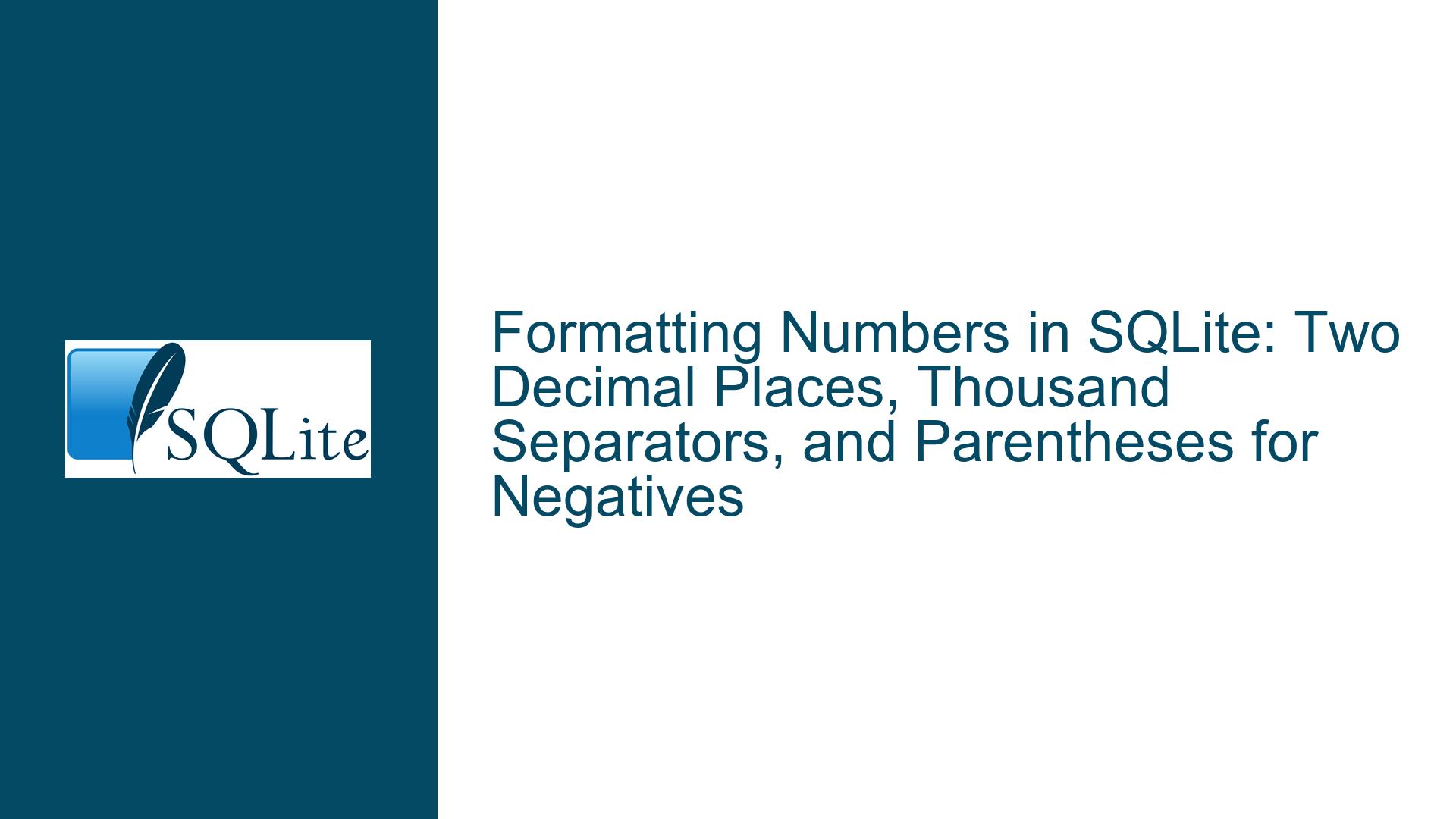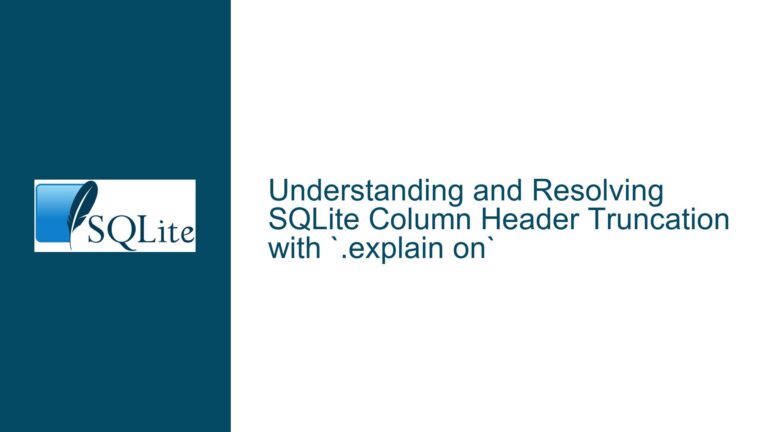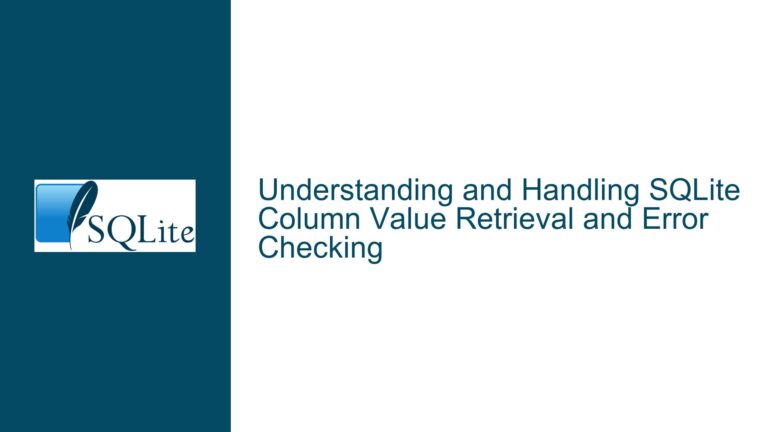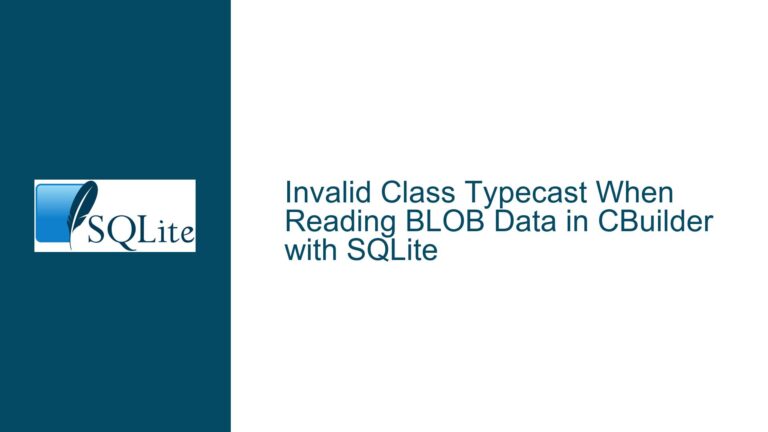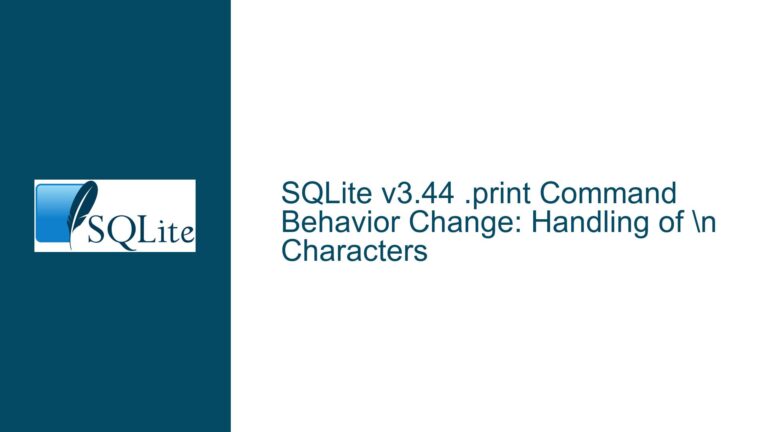Formatting Numbers in SQLite: Two Decimal Places, Thousand Separators, and Parentheses for Negatives
Issue Overview: Combining Decimal Precision, Thousand Separators & Negative Parentheses in SQLite
The challenge involves formatting numerical values in SQLite to meet three requirements simultaneously:
- Display numbers with thousand separators (e.g., 1,234,567)
- Enforce two decimal places with proper rounding (e.g., 1234567.4567 → 1,234,567.46)
- Represent negative numbers within round brackets instead of using a minus sign (e.g., -1234.56 → (1,234.56))
SQLite’s printf() function provides basic formatting capabilities but lacks native support for combining these requirements in a single format specifier. The complexity arises from three technical limitations:
printf()’s%,dformat handles thousand separators for integers but ignores fractional components%.2frounds to two decimal places but doesn’t support thousand separators- Negative number formatting with parentheses requires conditional string manipulation
A naive attempt to chain format specifiers like printf('%,.2f', value) fails because SQLite’s printf() implementation doesn’t support combining %d/%,d modifiers with floating-point precision specifiers. This forces developers to decompose the number into integer and fractional components, process each part separately, and then reassemble them with proper formatting rules.
Possible Causes: Why Native Format Specifiers Fail to Achieve Combined Requirements
1. Incompatibility Between Integer and Floating-Point Format Modifiers
SQLite’s printf() treats %d and %f as mutually exclusive format specifiers. The %,d modifier applies thousand separators only to integers, while %.2f handles decimals but omits separators. Attempting to merge these (e.g., %,.2f) throws a format error because the , (thousand separator) flag is valid only for integer conversions (%d, %i, %u).
2. Truncation vs. Rounding in Component Extraction
When splitting a number into integer and fractional parts using arithmetic operations (e.g., CAST(value AS INTEGER)), fractional digits are truncated rather than rounded. For example:
SELECT 1234567.4567 - CAST(1234567.4567 AS INTEGER); -- Returns 0.4567 (truncated)
This necessitates explicit rounding before separating components.
3. Negative Sign Handling Conflicts with Parentheses
The default negative sign (-) cannot coexist with parentheses formatting through standard printf() flags. Achieving (1,234.56) instead of -1,234.56 requires:
- Removing the negative sign
- Conditionally wrapping the absolute value in parentheses
- Ensuring the fractional part retains its magnitude
4. Modulo Operations and Floating-Point Precision
Extracting fractional digits via (abs(x)*100) % 100 introduces precision errors due to:
- Floating-point representation inaccuracies (e.g.,
0.1stored as0.09999999999999998) - Improper scaling when rounding (e.g., multiplying by 100 instead of 1000 before applying modulo)
Troubleshooting Steps, Solutions & Fixes: Building a Robust Formatting Workflow
Step 1: Decompose the Number into Sign, Integer, and Rounded Fractional Components
Extract Absolute Value and Determine Sign
SELECT
x AS original_value,
abs(x) AS absolute_value,
CASE WHEN x < 0 THEN '(' ELSE '' END AS opening_bracket,
CASE WHEN x < 0 THEN ')' ELSE '' END AS closing_bracket
FROM numbers;
This separates the sign handling from the numeric formatting, enabling conditional wrapping of negatives in parentheses.
Isolate Integer and Fractional Parts with Proper Rounding
To avoid truncation, explicitly round the value before decomposition:
SELECT
absolute_value,
CAST(round(absolute_value, 2) AS INTEGER) AS integer_part,
round(absolute_value, 2) - CAST(round(absolute_value, 2) AS INTEGER) AS fractional_part
FROM (SELECT abs(x) AS absolute_value FROM numbers);
Critical Insight: Rounding before extraction ensures 1234567.4567 becomes 1234567.46, where the integer part is 1234567 and the fractional part is 0.46.
Step 2: Scale and Extract Rounded Fractional Digits Correctly
Avoid Floating-Precision Errors with Integer Arithmetic
Multiply the rounded fractional part by 100 and cast to an integer:
SELECT
CAST(round(fractional_part * 100, 0) AS INTEGER) AS fractional_digits
FROM (...);
This converts 0.4567 → 46 (after rounding) instead of 45 (truncation).
Handle Edge Cases with Modulo Operations
For values like 42.00, ensure fractional digits display as "00":
SELECT
printf('%02d', fractional_digits) AS padded_fraction
FROM (...);
The %02d format pads single-digit results (e.g., 3.14 → 14, 42.00 → 00).
Step 3: Assemble Components with printf() and Conditional Formatting
Combine Thousand-Separated Integer and Padded Fraction
SELECT
printf('%,d.%02d', integer_part, fractional_digits) AS number_body
FROM (...);
The %,d adds thousand separators to the integer part, while %02d ensures two decimal digits.
Wrap Negative Values in Parentheses
Inject the opening/closing brackets conditionally:
SELECT
printf('%s%s%s', opening_bracket, number_body, closing_bracket) AS formatted
FROM (...);
Final Optimized Query
WITH numbers (x) AS (
VALUES (-1234567.4567), (7654321.7654), (42), (-3.14159)
)
SELECT
printf(
'%s%,d.%02d%s',
CASE WHEN x < 0 THEN '(' ELSE '' END,
CAST(round(abs(x), 2) AS INTEGER),
CAST(round((abs(x) - CAST(round(abs(x), 2) AS INTEGER)) * 100, 0) AS INTEGER),
CASE WHEN x < 0 THEN ')' ELSE '' END
) AS formatted
FROM numbers;
Output:
┌───────────────────┐
│ formatted │
├───────────────────┤
│ (1,234,567.46) │
│ 7,654,321.77 │
│ 42.00 │
│ (3.14) │
└───────────────────┘
Advanced Considerations
1. Handvery Large Numbers (Overflow Risks)
When dealing with values exceeding 2^63-1 (~9.2e18), cast to TEXT early to prevent integer overflow:
CAST(round(abs(x), 2) AS TEXT) AS integer_part -- Not recommended; breaks thousand separators
Workaround: Use printf('%,.0f', round(abs(x), 2)) to format the integer part as a float without decimals.
2. Localized Thousand Separators
SQLite uses , as the thousand separator in %,d, which might conflict with locales using . for this purpose. No native configuration exists; consider post-processing:
REPLACE(formatted, ',', '.') AS german_format
3. Performance Implications
The decomposition/rounding approach requires multiple arithmetic operations and type casts. For large datasets, precompute formatted values in a VIEW or cache results in a VIRTUAL TABLE.
4. Alternative Using User-Defined Functions
For projects allowing extensions, register a C function format_currency(value) via SQLite’s API to handle all formatting rules in native code.
Common Pitfalls & Debugging Tips
Pitfall 1: Incorrect Rounding Due to Double Casting
Symptom: 1234567.4567 formats as 1,234,567.45 instead of 1,234,567.46
Cause: Rounding applied after truncating the fractional part:
-- Wrong:
CAST(abs(x) AS INTEGER) AS integer_part,
round((abs(x) - CAST(abs(x) AS INTEGER)) * 100, 0) AS fractional_digits
Fix: Round the entire value before decomposition:
round(abs(x), 2) AS rounded_value,
CAST(rounded_value AS INTEGER) AS integer_part,
(rounded_value - integer_part) * 100 AS fractional_part
Pitfall 2: Missing Leading Zero in Fractional Part
Symptom: 3.1 displays as 3.1 instead of 3.10
Cause: Using %d instead of %02d for fractional digits
Fix: Enforce two-digit padding:
printf('%s%,d.%02d%s', ...)
Pitfall 3: Parentheses Around Positive Numbers
Symptom: All values appear wrapped in parentheses
Cause: Incorrect CASE condition in sign handling:
CASE WHEN x <= 0 THEN '(' ELSE '' END -- Incorrectly includes zero
Fix: Use strict inequality:
CASE WHEN x < 0 THEN '(' ELSE '' END
By systematically addressing component extraction, rounding, and conditional formatting, this approach achieves compliant numeric formatting within SQLite’s constraints.
